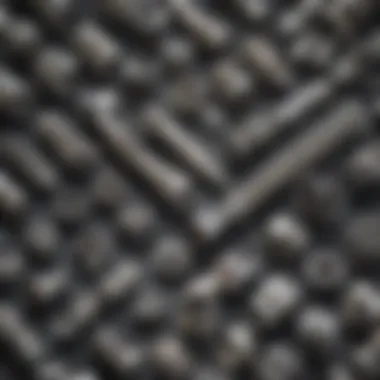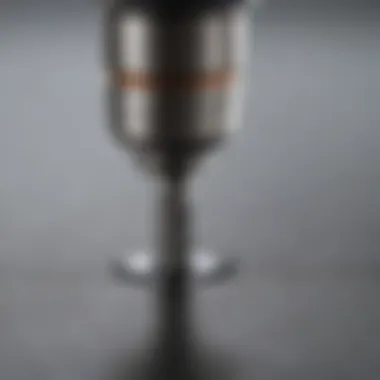Essential Dremel Bits for Stainless Steel Projects


Intro
Dremel bits tailored for stainless steel serve as essential tools in home improvement projects. As versatility and precision are paramount, understanding the different bits available is crucial for effective usage. Each project may call for specific bit types to achieve the best results. This comprehensive guide aims to dissect the topic systematically. It will include aspects ranging from types and applications to maintenance tips, empowering readers to pick the right bit and succeed in their endeavors.
Overview of Topic
Working with stainless steel can seem daunting. It is a robust material with unique properties that require careful consideration and appropriate tools for shaping and modifying. Dremel bits, engineered specifically for stainless steel, address these challenges and enhance efficiency in the home improvement sector.
The importance of Dremel bits geared towards stainless steel cannot be overstated. Properly selecting and using the right tools simplifies tasks and improves overall results. Accurate, precise cuts and finishes depend heavily on a combination of technique and the quality of the Dremel bit.
Common Challenges and Solutions
Homeowners often face hurdles when working with stainless steel.
- Bit wear: Stainless steel is abrasive. Common issues include bits wearing down quickly, leading to uneven results.
- Heat buildup: As the material is machined, excessive heat can reduce precision and lead to issues such as warping.
- Difficulty in shaping: Shaping intricate details on stainless steel can prove challenging.
Solutions and tips to overcome these challenges:
- Choose the Right Bit: Utilize bits designed explicitly for metalwork. This maximizes efficiency and life span.
- Manage Speed: Operate the Dremel at a lower RPM to minimize heat production. Slowly is often better for precision and comfort when working.
- Lubrication: Regularly use cutting oils to cool the bit and enhance performance.
“Understanding tools and the materials you work with can elevate your home improvement skills greatly.”
Product Recommendations
Many Dremel products provide effective solutions.
- Dremel 9901 Tungsten Carbide Bit: Effective for cutting, shaping, and engraving on stainless steel. Its hardened material provides durability and precision.
- Dremel 426 1-1/4-Inch Wheel: This is a fiberglass-reinforced bit designed for sanding or smoothing stainless steel surfaces.
- Dremel 84922 Polishing Compound: Great for achieving a brilliant finish on stainless steel surfaces after cutting or defining shapes.
Each product stands out with unique benefits:
- Durability ensures long-lasting performance even in rigorous applications.
- Versatility allows users to engage in various tasks, always with a focus on refinement.
- Compatibility with most Dremel tools makes them ideal for any home workshop.
Step-by-Step Guides
Successfully implementing improvements starts with a solid approach. Here’s a simple guideline to use Dremel bits effectively:
- Select your bit based on the project requirements and material situation, i.e., size, shape, and thickness of stainless steel.
- Prepare your workstation, ensuring it is clear and safe for usage. Wear protective gear—goggles and gloves.
- Set up your Dremel: Attach the chosen bit securely. Check that it’s fitted correctly and not too loose.
- Adjust speed settings: Lower RPM is essential for controlling tool performance on stainless steel. Make necessary adjustments.
- Work patiently: Gradually approach the material with the Dremel, apply gentle pressure, and never rush through transitions.
- Cooling technique: Between cuts, or when significant heat initiates, allow the bit to cool completely or apply lubricants to maintain efficiency.
- Finishing touch: Once your project reaches completion, polish the surface meticulously for a refined and professional outcome.
With this guide, anyone can navigate the Dremel bits specifically tailored for stainless steel proficiently, turning challenges into accomplished results.
Understanding Dremel Tools
Dremel tools have become integral for many metalworking projects, especially when handling materials like stainless steel. Their versatility and precision render them key instruments for both hobbyists and professionals. This section aims to provide foundational knowledge regarding Dremel tools and their relevance when specificall working with metal options like stainless steel.
The Role of Dremel in Metalworking
Dremel tools serve a unique function in metalworking. Their compact design allows for intricate work that larger machines cannot achieve. They are particularly effective for CNC engravings, adjustments, and delicate tasks in shaping metal.
Metalworkers appreciate these tools for their rotary capabilities, which blends easily in various tasks, including cutting, carving, and polishing stainless steel. Speed settings are adjustable, where higher RPMs are often necessary for tougher materials.
One specific feature that sets Dremel apart includes its interchangeable bits. Users can simply swap bits depending on their tasks. For example, it can go from drilling large holes to creating finer engravings with ease. This adaptability makes it appealing when transitioning between different jobs within the same project.
Overview of Dremel Bits
Dremel bits come in a range of shapes and materials, tailored to various applications. Understanding the types is essential for selecting the appropriate bit for specific tasks involved.
- Wood Bits: Not applicable for metal, they serve woodwork purposes only.
- Metal Bits: Designed specifically for metal surfaces. This category further subdivides into bits for drilling, cutting, grinding, routing, and polishing.
- Specialty Bits: Include router bits, engraving tips, etc.
Within the overall group of metal bits for stainless steel around, some use diamond content for added durability. Others will consist of high-speed steel components, trusted for their lasting performance.
In essence, each bit serves a particular utility in projects involving Dremel tools completely. Knowing how and when to use them effectively can impact the overall quality of the work produced.


Choosing the suitable bit often decides the ease of work and quality of output significantly, particularly with materials like stainless steel.
Stainless Steel and Its Properties
Understanding stainless steel's properties is crucial when working with Dremel bits. Stainless steel is a popular material for various projects in home improvement, making knowledge of its specific qualities necessary for effective tooling. The selection of Dremel bits is directly influenced by the nature of stainless steel, which possesses distinct attributes compared to other metals.
These attributes include its corrosion resistance, durability, and aesthetic appeal. Corrosion resistance allows stainless steel to maintain its appearance and integrity in challenging environments. This resistance to rust helps in ensuring that projects last longer with fewer maintenance requirements.
Characteristics of Stainless Steel
Stainless steel is not a single composition but a family of alloys. Its most prominent characteristic is corrosion resistance, achieved by adding chromium, which forms a protective layer on the metal's surface. Additionally, the material is known for its high strength, which provides durability.
Other noteworthy characteristics include:
- Heat resistance: Stainless steel withstands high temperatures without deforming, making it ideal for various applications, from kitchenware to structural elements.
- Workability: While tough, it can be shaped and welded. This entails using appropriate Dremel bits tailored for metal cutting or grinding.
- Hygiene: Stainless steel does not harbor bacteria, adding to its appeal for home and kitchen uses.
Understanding these characteristics is beneficial for selecting the right bit when performing tasks like cutting, drilling, or grinding.
Challenges of Working with Stainless Steel
Working with stainless steel is not without its challenges. Its high density and strength can impede the use of conventional tools. Specific challenges one may encounter include:
- Tool wear: Using the wrong Dremel bit may lead to rapid wear or damage, as stainless steel can be tough on cutting edges
- Heat generation: Due to its density, cutting stainless steel often produces a significant amount of heat that can lead to tool degradation.
- Burr formation: Edges may warp or burr when not properly managed, making it important to select bits designed for precision cutting.
It is crucial to address these challenges directly. Selecting the appropriate Dremel bits allows for efficient cutting. Additionally, using a steady pace and proper techniques helps mitigate heat generation while also ensuring control during the work process.
Knowledge of theoretical and practical properties can significantly enhance your project’s outcome when handling stainless steel effectively.
Types of Dremel Bits for Stainless Steel
When selecting tools for working on stainless steel, the type of Dremel bit employed is crucial. Each variant holds distinct characteristics, benefits, and applications, greatly influencing the quality and efficiency of the work. Familiarity with the following bit types helps users match the tools to specific tasks effectively, ensuring desired results, especially when durability and precision are key factors.
Diamond Bits
Diamond bits feature a high concentration of industrial diamonds on their surface. These bits are particularly suited for cutting, grinding, and etching stainless steel. The benefits of using diamond bits include their superior hardness and longevity. They can work for extended periods without noticeable wear.
Diamond bits are ideal for projects requiring precise engraving or intricate designs on stainless steel. Also, they minimize overheating, which is crucial for maintaining the integrity of the metal.
- High precision for detailed work
- Durable and long-lasting
- Reduces the risk of metal damage during cutting
Carbide Bits
Carbide bits are well-regarded for their toughness and effectiveness in cutting through tougher materials such as stainless steel. Made from tungsten carbide, they can withstand high levels of stress and temperature, allowing for effective grinding and shaping tasks.
These bits can create clean cuts and smooth finishes, making them a favored choice among both hobbyists and professionals. The selection of fine-grade and coarse varieties allows users to adapt to diverse project specifications.
- Effective for rigorous metalworking tasks
- Provides clean and smooth cuts
- Various grades available for project diversity
High-Speed Steel (HSS) Bits
HSS bits combine good strength with resistance to wear. These bits maintain their sharpness and cutting ability longer than standard steel bits. HSS bits are useful for drilling and shaping stainless steel, giving users exceptional control over their projects.
While they may not last quite as long as carbide or diamond bits in heavy use, they remain highly effective for various home projects concerning metalworking.
- Good balance of strength and durability
- Suitable for drilling and shaping tasks
- Affordable and versatile option
Aluminum Oxide Bits
Aluminum oxide bits serve as another option for working with stainless steel. They are primarily known for their abrasive qualities, making them efficient at grinding and polishing metal surfaces. Particularly in situations where fine finishes are desired, these bits excel in surface preparation.
The cost-effectiveness of aluminum oxide bits creates value, especially for simpler or more extensive projects. Although not as durable as their carbide or diamond counterparts, they remain a practical choice for light to medium applications.
- Excellent for grinding and polishing
- Affordable and value-oriented
- Ideal for surface preparation tasks


Understanding the types of Dremel bits is essential for anyone working with stainless steel. Choosing the right bit not only influences the ease of the task but also contributes to the outcome's durability and appearance.
Choosing the Right Bit for Your Project
Choosing the correct Dremel bit for stainless steel is crucial to achieving the desired results in any metalworking project. The right bit not only ensures precision and efficiency but also prolongs the lifespan of the tool. Application-specific bits can differ significantly in shape, cutting style, and material. Therefore, understanding the bit's purpose and selecting one that aligns with project needs offers clear advantages. The outcome can greatly depend on this initial choice.
Evaluating Project Requirements
When assessing project requirements, consider the specific task at hand. Is the job cutting, shaping, engraving, or polishing? Each function demands a different bit type, influencing the overall outcome. For instance, carbide bits are ideal for cutting, while diamond bits work well for engraving.
Additionally, examining material thickness is vital. Thicker stainless steel might need more robust bits for effective cutting. It is also important to assess surface finish requirements. A polished surface often requires finer bits to achieve a smooth result. Techniques should match the intricacies of the project; otherwise, users may find ineffective or unsatisfactory results.
Keep the following points in mind while evaluating project requirements:
- Type of Operation: Identify whether it requires cutting, engraving, or grinding.
- Thickness of Material: Assess if the bit can handle the dimensions.
- Desired Finish: Define the standard of finishing or polishing required.
Speed and Precision Considerations
Speed and precision are intertwined factors in selecting Dremel bits for stainless steel projects. Maximizing productivity often leads to hasty choices, which can diminish quality. Therefore, two considerations are paramount: both motor speed settings and bit material impact this area significantly.
Starting off, understanding motor capacity helps in selecting the correct speed settings. Harder materials, such as stainless steel, often benefit from lower speeds to minimize wear and prevent damage. This applies particularly when using diamond or carbide bits which require cooling periods to maintain quality or grinding efficiency.
The following include key rundowns for speed consideration:
- Lower Speeds: Crucial for cutting tough materials or achieving fine finishes.
- Higher Speeds: Materials compatible with fast spins improve efficiency while polishing or engraving.
Precision related factors are vital too. The cutting angle and bit configuration can influence the level of detail achievable. Using specific types appropriately generates clean edges or surfaces in complex metals, ensuring an aesthetic appearance suited for any purpose.
In summary, evaluating project particularities, accepted standards of finish, and understanding motor capabilities leads to better outcomes on stainless steel projects.
Techniques for Using Dremel Bits on Stainless Steel
Using Dremel bits on stainless steel requires a solid understanding of techniques to maximize their effectiveness. Proper techniques enhance efficiency and precision. The benefits of mastering these methods can be profound, transforming a tedious project into a seamless process. Correct application also minimizes wear on the bits themselves, resulting in increased longevity.
Proper Attachment and Setup
Attaching the bit properly is critical to ensure safety and performance. First, select the appropriate bit for your specific task. This might be a diamond bit for engravings or a high-speed steel bit for cutting. Secure it tightly to prevent any shifting during operation. The setup process involves ensuring your Dremel tool is on a stable surface. Prioritize checking the tool's speed settings. Stainless steel typically requires higher speeds to effectively penetrate the material. Always refer to the Dremel manual for the best guidance on setup specific to your model.
- Steps to Properly Attach the Bit:
- Unplug your Dremel tool to avoid any accidental starting.
- Use the appropriate wrench to loosen the chuck.
- Insert the chosen bit and gently tighten the chuck securely.
- Ensure that the bit sits flush and stays centered.
Effective Cutting and Grinding Techniques
Once the bit is installed, it is essential to apply the right cutting or grinding techniques. Start with smooth motions, applying less pressure than you might normally use. It is common to think one should force the tool, but letting the Dremel do the work is more effective. Keep a consistent angle. For precision jobs, guide the tool gently as needed.
Tip: Maintaining even pressure allows for cleaner cuts and prevents bit overheating.
Cutting Techniques
- Begin with an outline of the cut line, then proceed to cut through the material gradually.
- Always cut along the line, maintaining the same depth.
Grinding Techniques
- For smoothing edges, hold the tool at a 45-degree angle.
- Move it back and forth for an even finish.
Maintaining Control and Stability
Control is paramount while working with stainless steel because the material's toughness can sometimes lead to hesitation. Find a comfortable grip on the Dremel tool, ensuring you have guided support. Use both hands when necessary for intricate tasks. To enhance stability, consider using clamps to secure the workpiece. Employing a guide may also improve your overall efficiency.
- Additional Control Tips:
- Position the Dremel tool perpendicular to the work surface for improved grip.
- If working on a larger project, take breaks to manage fatigue in your hands, allowing for continued precision.


Excellent techniques do much more than simply maintain safety; they ensure the results meet expectations. Investing time in these skills will undoubtedly reflect in the final outcome.
Maintenance of Dremel Bits
Maintaining Dremel bits is crucial for ensuring their longevity and optimal performance, especially when working with stainless steel. Proper maintenance practices involve cleaning and storing bits correctly to avoid damage. Not only does maintenance prolong the life of your tools, but it also enhances the quality of work you can achieve. Each type of bit requires its approach, but the overall goal is the same: to keep them in peak condition.
Cleaning Dremel Bits
Cleaning Dremel bits is an essential part of their maintenance. Residue from stainless steel can accumulate on bits, reducing their effectiveness. Regular cleaning prevents this buildup and ensures that the bits perform well during use.
To clean Dremel bits, follow these steps:
- Unplug your Dremel tool. Safety should be the first priority when conducting any maintenance on your tools.
- Remove the bit. Use an appropriate wrench to loosen and remove the bit for easier handling.
- Use a soft brush. Gently brush away any debris or metal shavings that have lodged in the bit. A toothbrush or small wire brush works effectively for this purpose.
- Soak in cleaning solution. For tough residue, a solution of warm water and mild soap can be used. Soak the bits for a few minutes to loosen stubborn material.
- Rinse and dry thoroughly. It’s essential to ensure that no moisture remains on the bits. Pat them dry with a clean cloth or let them air dry completely.
Cleaning your Dremel bits enhances their performance. By following these steps routinely, you ensure consistent results and prolonged usage, making the maintenance process integral to quality workmanship.
Storage Best Practices
Storing Dremel bits properly is another critical aspect of their maintenance. Improper storage can lead to wear, dulling, or even damage to your bits. A thoughtful approach to storage ensures that your bits remain in optimal condition when you need them.
Here are practical storage best practices:
- Use a dedicated storage case. A professional tool case or a simple container specifically for your Dremel bits helps keep them organized and prevents scattering or damage in storage.
- Label your storage options. Knowing the types of bits you have and where they are can save time during your next project. Label compartments in your case to quickly identify each bit.
- Keep bits dry. Moisture is detrimental to metal tools. Ensure your storage area is dry to prevent rust or corrosion from developing.
- Avoid contact with hard edges. If you must stack your bits, ensure they are laid flat to avoid dulling the tips or chiping.
- Store at room temperature. Extreme temperatures can affect bit integrity. A climate-controlled storage space is ideal.
With these storage practices, your Dremel bits will be readily available and in perfect shape for your stainless steel projects. Taking the time to maintain and store your tools correctly enhances not only their lifespan but also the quality of the work you deliver.
Safety Precautions When Using Dremel Bits
Safety is a fundamental aspect when working with Dremel tools and bits, especially concerning stainless steel. These materials can pose certain risks and working with them generally requires a clear understanding of the potential dangers one may face. Taking safety precautions helps avoid accidents and ensures a smooth working process. Users should prioritize safety for both protection and efficiency. Ignoring safety can lead to injuries that could be severe, and thus awareness is crucial.
Recommended Protective Gear
Using the proper gear is essential when engaging in metalworking tasks with Dremel bits. Here is a list of suggested protective items:
- Safety goggles: To protect your eyes from flying debris and fine metal particles.
- Dust mask or respirator: This helps minimize inhalation of harmful dust, which can arise when cutting or grinding stainless steel.
- Ear protection: Dremel tools can produce significant noise; using earplugs or earmuffs reduces the risk of hearing damage over time.
- Gloves: While it's important to focus on mobility with suitable gloves, they should fit well, allowing for seamless operation without being excessively bulky.
- Protective clothing: Always wear garments that cover your skin. Avoid loose-fitting attire. This can prevent catching on tools, while protecting against tool impact.
Being adequately dressed not only promotes workmanship but ensures that injuries are kept minimal if accidents occur.
Understanding Risks Associated with Stainless Steel
Working with stainless steel inherently comes with specific risks due to its nature. Some of the primary concerns include:
- Heat Generation: When cutting stainless steel, the process generates heat. This heat can cause burns if touched. It is advisable to let the material cool down before handling.
- Metal Dust and Particles: Cutting or grinding may create sharp metal fragments that can fly off unexpectedly, injuring skin or piercing through clothing. Staying protected can mitigate these injuries and is highly recommended.
- Vibration Effects: Long exposure to vibrating tools can lead to health risks like hand-arm vibration syndrome. Rotating tools generate vibration, so users should ensure their grips are secure and take breaks to reduce fatigue.
- Reactive Properties: Stainless steel can have chemical reactions with some environments or materials. It is wise to be aware of the surrounding workspace and other materials in use.
Remember, your safety directly impacts both the quality of your work and your long-term wellbeing.
Raising awareness on risks not only equips users to protect themselves but also aids their process quality as a strong safety routine boosts their efficiency.
The End and Final Thoughts
When exploring techniques and tools for metalworking, particularly when working with stainless steel, what you select can critically shape your outcomes. This concluding section outlines essential considerations and reinforces why understanding Dremel bits is crucial for effective project completion.
By examining various types of Dremel bits, homeowners can determine which tools are tailored fits for their specific tasks. Each bit type—whether diamond, carbide, high-speed steel, or aluminum oxide—brings distinct advantages. The corresponding applications ensure that results range from tedious material removal to smooth polishing finishes. Knowing the right bit minimizes time wasted on incorrect choices and yields better quality work overall.
Understanding factors such as speed, precision, and how to maintain bits properly offers additional benefit. For those who prioritize savings in both time and material, mastering these details cannot be overlooked. Regular maintenance, alongside knowledge in use techniques, prolongs the lifespan of tools and improves overall results. Investing effort in this area translates to both craft proficiency and satisfaction upon project completion.
Recap of Key Points
- Different types of Dremel bits offer unique advantages for stainless steel projects, including efficacy in cutting, grinding, and polishing.
- Matching projects with specific bit needs prevents wasted effort and lowers frustration levels.
- Maintenance practices, including cleaning and storage, significantly extend the utility of Dremel bits.
- Safety precautions play critical roles in reducing risks associated with metalworking.
Future Trends in Dremel Technology
The landscape of power tools continually evolves, and Dremel technology is no exception. Innovations in material science and manufacturing are leading to improved bits that offer enhanced durability and precision. As the demand for projects involving stainless steel grows, manufacturers are likely to invest in developing specialized bits that cater to intricate designs or larger, more complex projects.
There is also the potential for advancements in electronic features. This could range from bits that instantaneously adjust speeds based on pressure applied or tools designed to integrate seamlessly with user interfaces for programming complex tasks.
In addition, material technology may soon result in bits that reduce friction, leading to less heat production, which can compromise stainless steel projects. New developments may also promote user safety through smarter designs that minimize the likelihood of accidents during use.
In this way, staying informed of industry trends ensures hobbyist familiarity from understanding new offerings to enhancing crafting skills in practical ways.







